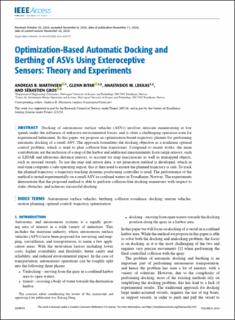| dc.contributor.author | Martinsen, Andreas Bell | |
| dc.contributor.author | Bitar, Glenn Ivan | |
| dc.contributor.author | Lekkas, Anastasios M. | |
| dc.contributor.author | Gros, Sebastien | |
| dc.date.accessioned | 2020-11-25T14:18:22Z | |
| dc.date.available | 2020-11-25T14:18:22Z | |
| dc.date.created | 2020-11-24T11:00:55Z | |
| dc.date.issued | 2020 | |
| dc.identifier.citation | IEEE Access. 2020, 8 204974-204986. | en_US |
| dc.identifier.issn | 2169-3536 | |
| dc.identifier.uri | https://hdl.handle.net/11250/2689614 | |
| dc.description.abstract | Docking of autonomous surface vehicles (ASVs) involves intricate maneuvering at low speeds under the influence of unknown environmental forces, and is often a challenging operation even for experienced helmsmen. In this paper, we propose an optimization-based trajectory planner for performing automatic docking of a small ASV. The approach formulates the docking objective as a nonlinear optimal control problem, which is used to plan collision-free trajectories. Compared to recent works, the main contributions are the inclusion of a map of the harbor and additional measurements from range sensors, such as LIDAR and ultrasonic distance sensors, to account for map inaccuracies as well as unmapped objects, such as moored vessels. To use the map and sensor data, a set generation method is developed, which in real-time computes a safe operating region, this is then used to ensure the planned trajectory is safe. To track the planned trajectory, a trajectory-tracking dynamic positioning controller is used. The performance of the method is tested experimentally on a small ASV in confined waters in Trondheim, Norway. The experiments demonstrate that the proposed method is able to perform collision-free docking maneuvers with respect to static obstacles, and achieves successful docking. | en_US |
| dc.language.iso | eng | en_US |
| dc.publisher | Institute of Electrical and Electronics Engineers (IEEE) | en_US |
| dc.rights | Navngivelse 4.0 Internasjonal | * |
| dc.rights.uri | http://creativecommons.org/licenses/by/4.0/deed.no | * |
| dc.title | Optimization-Based Automatic Docking and Berthing of ASVs Using Exteroceptive Sensors: Theory and Experiments | en_US |
| dc.type | Peer reviewed | en_US |
| dc.type | Journal article | en_US |
| dc.description.version | publishedVersion | en_US |
| dc.source.pagenumber | 204974-204986 | en_US |
| dc.source.volume | 8 | en_US |
| dc.source.journal | IEEE Access | en_US |
| dc.identifier.doi | 10.1109/ACCESS.2020.3037171 | |
| dc.identifier.cristin | 1851482 | |
| dc.description.localcode | Open Access CC-BY | en_US |
| cristin.ispublished | true | |
| cristin.fulltext | original | |
| cristin.qualitycode | 1 | |

